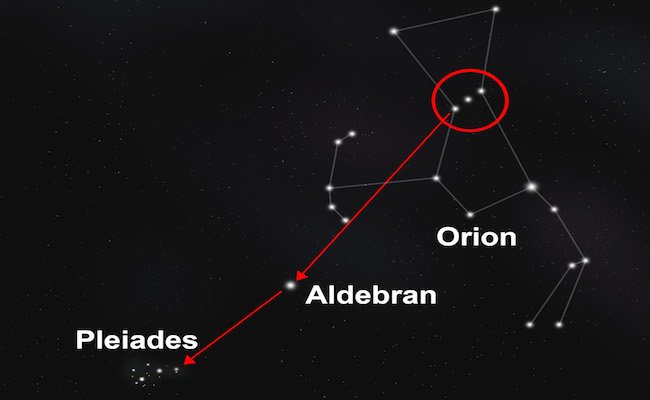The Pleiades Star Cluster

Looking into the night sky we often look for constellations. Did you know that there appears a star cluster that shines bright like diamonds in the sky? Read on to learn more about the Pleiades star cluster.
The Pleiades, often known as the Seven Sisters, shine like a handful of jewels in the sky. This grouping of stars is prominent in the constellation Taurus. To find them, follow a line from Orion’s shoulder through Taurus’s bright star Aldebaran. This bright congregation of stars appears highest in the sky during the fall and winter.
Open Cluster Stars
An open cluster is a collection of 10 to 1000 stars in a region about 25 parsecs in diameter. The collection is bound weakly by gravity. One parsec is equal to about 3.26 light-years (31 trillion km or 19 trillion miles) in length. Some open clusters are quite small and some are large, but they all have an open, transparent appearance because the stars are not crowded together. All the stars in a star cluster have the same age but differ in mass.
Aging Star Cluster
As a star cluster ages, its main sequence grows shorter like a candle burning down. In astronomy, the main sequence is a continuous and distinctive band of stars that appear on plots of stellar color versus brightness. Consequently, the age of the star cluster can be determined by looking at the turnoff point. The turnoff point for a star refers to the point on the Hertzsprung-Russell diagram where it leaves the main sequence after the exhaustion of its main fuel. Stars at the turnoff point have lived out their lives and are about to die. As a result, the life expectancy of the stars at the turnoff point equals the age of the cluster.

Viewing the Pleiades
Northern Hemisphere
Look for the Pleiades in autumn and winter. In the Northern Hemisphere, the Pleiades star cluster becomes visible to evening observers in October and disappears in April. November is the best time to look for the Pleiades. They can be visible from dusk to dawn and reach their highest point in the sky.
- In early October, the Pleiades become visible a couple hours after sunset. By about February, the Pleiades are already high in the sky at sunset. (The exact timing depends on your latitude.)
- The Pleiades are visible in late summer and early autumn as well, but only in the middle of the night.
Southern Hemisphere
Watch for the cluster in spring and summer. They are visible from about October to April, during the Southern Hemisphere’s spring and summer months.
- Face the northern sky. During late November, the Pleiades rise in the northeast around dusk and travel west until dawn. As the season’s progress, the Pleiades start higher in the sky when the stars appear, and spend less time in the sky.
Pleiades Facts
The cluster actually holds about 500 stars. By and large, they are relatively young at about 100 million years old. Located 400 light years away, they may only hold together as a cluster for another 250 million years before separating. In the ancient Mediterranean world, the day that the Pleiades cluster first appeared in the morning sky before sunrise announced the opening of the navigation season.The modern-day festival of Halloween originates from an old Druid rite that coincided with the midnight culmination of the Pleiades cluster. It was believed that the veil dividing the living from the dead is at its thinnest when the Pleiades reaches its highest point in the sky – at midnight.
Shining beautifully in the night sky this star cluster may be viewed from both hemispheres with the naked eye. With a telescope in hand you will be able to view more in the star cluster, but overall the experience of seeing them together in the night sky will be quite rewarding.
